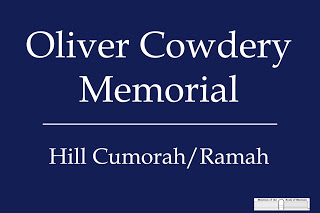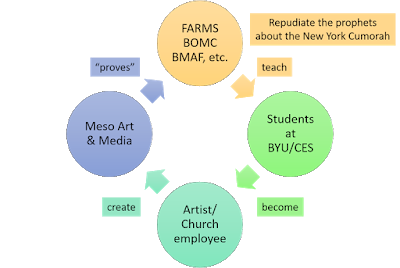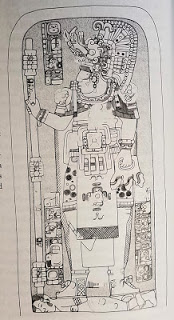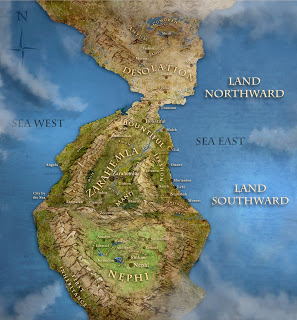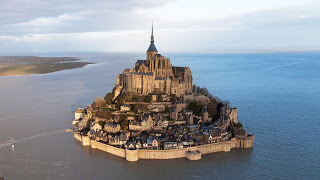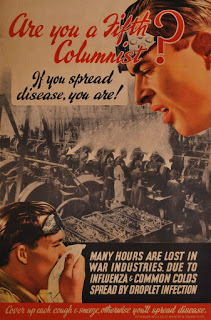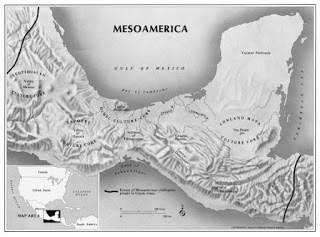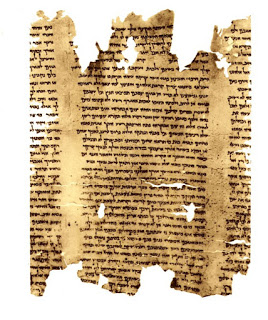I’ll put it another way. We have an official report from two Apostles, written to the President of the Church and the Quorum of the Twelve, regarding their interview with one of the Three Witnesses, and the M2C intellectuals want you to believe it is not credible.
M2C proponents take offense when I point this out. I’ve given plenty of examples of their treatment of Oliver Cowdery. In this post I’ll give some examples of how they have treated David Whitmer.
This is all the worse because the New York Cumorah does not necessarily exclude Mesoamerica as a possible setting for some Book of Mormon events. I don’t think it’s a good fit, but others do, and that’s fine with me, so long as they don’t reject what the prophets have taught about the New York Cumorah.
In 1878 Orson Pratt and Joseph F. Smith, stopped in Richmond and met with David Whitmer who was then 73 years old. The two Apostles sent a formal report of their interview to President John Taylor and the Council of the Twelve. It was published in theMillennial Star (Vol. 40, No. 49, Dec. 9, 1878, p. 769, online here, scroll down to Dec. 9 and open the first file) titled “Report of Elders Orson Pratt and Joseph F. Smith.”
During the interview, Whitmer said he, Oliver and Joseph were riding in a wagon on the way to Fayette when a man appeared next to the wagon. “I invited him to ride if he was going our way. But he said very pleasantly, “No, I am going to Cumorah.’ This name was something new to me, I did not know what Cumorah meant. We all gazed at him and at each other, and as I looked round enquiringly of Joseph the old man instantly disappeared, so that I did not see him again….It was the messenger who had the plates, who had taken them from Joseph just prior to our starting from Harmony.”
The M2C intellectuals don’t like this interview because Whitmer recalls a divine messenger himself using the term Cumorah to describe the site in New York. (In this interview, Whitmer did not identify the individual, but in two other accounts, he claimed it was one of the three Nephites, as I explain below.) Whitmer had never heard the word Cumorah and didn’t know what it meant, which makes sense because this occurred in 1829 and while he had just witnessed the plates (and much more) a few days previously, the Book of Mormon was yet to be published. Whitmer was with Oliver Cowdery and Joseph Smith when the messenger mentioned Cumorah. If Whitmer was right, then everything the M2C intellectuals say about New York Cumorah collapses; i.e., the early Saints knew New York was in Cumorah because a divine messenger told them.
Before I give examples of how M2C intellectuals deal with Whitmer’s 1878 interview, here’s a comment about witnesses and testimony.
_____________________
Early in my career I was a prosecutor. Much of the job required an assessment of the credibility of witnesses. In most cases, I evaluated witness statements taken by the police or investigators, comparing different versions of events as related by different people. I interviewed witnesses, examined and cross-examined them in court, etc. In my opinion, Oliver Cowdery and David Whitmer are exceptionally reliable witnesses.
In court, judges instruct the jury how to evaluate witnesses. Here are some model jury instructions that we could use to evaluate Cowdery and Whitmer. I’ve bolded some key points.
A witness is a person who has knowledge related to this case. You will have to decide whether you believe each witness and how important each witness’s testimony is to the case. You may believe all, part, or none of a witness’s testimony.
In deciding whether to believe a witness’s testimony, you may consider, among other factors, the following:
(a) How well did the witness see, hear, or otherwise sense what he or she described in court?
(b) How well did the witness remember and describe what happened?
(c) How did the witness look, act, and speak while testifying?
(d) Did the witness have any reason to say something that was not true? Did the witness show any bias or prejudice? Did the witness have a personal relationship with any of the parties involved in the case? Does the witness have a personal stake in how this case is decided?
(e) What was the witness’s attitude toward this case or about giving testimony?
Sometimes a witness may say something that is not consistent with something else he or she said. Sometimes different witnesses will give different versions of what happened. People often forget things or make mistakes in what they remember. Also, two people may see the same event but remember it differently. You may consider these differences, but do not decide that testimony is untrue just because it differs from other testimony.
However, if you decide that a witness deliberately testified untruthfully about something important, you may choose not to believe anything that witness said. On the other hand, if you think the witness testified untruthfully about some things but told the truth about others, you may accept the part you think is true and ignore the rest.
Do not make any decision simply because there were more witnesses on one side than on the other. If you believe it is true, the testimony of a single witness is enough to prove a fact.
_________________________
Now, what do M2C intellectuals say about David Whitmer?
For convenience, I’ll post the entire interview at the end of this post. But first, here are some examples of how M2C intellectuals handle this interview. Quotations are in blue.
At the outset, I note that the citation cartel rarely provide a citation to the 1878 Whitmer interview that anyone can find. If they refer to the interview at all, they usually quote the excerpt from the interview about Whitmer’s experience as one of the Three Witnesses, and then cite Lyndon Cook’s 1982 book, David Whitmer Interviews, which is out of print (used price is $47.49 on Amazon). Examples from FAIR MORMON are here and here. Matt Roper cites Cook here. John Welch does the same thing in Opening the Heavens, p. 299, as does Jeff Lindsay here, and there are many other examples. Another oft-cited book, Richard Lloyd Anderson’s otherwise excellent and detailed Investigating the Book of Mormon Witnesses, doesn’t even mention the 1878 interview.
Brant Gardner, 2015: Footnote 22, p. 375, Traditions of the Fathers: “The earliest possible connection between the New York hill and the Book of Mormon Cumorah comes from an 1878 interview with David Whitmer by Orson Pratt and Joseph F. Smith, ‘Report of Elders Orson Pratt and Joseph F. Smith,’ 772-73: [quoting the Cumorah incident]
[I give full credit to Gardner for quoting from the interview, even if he buried it in a footnote. But he gives a page reference without a citation, so no one can look it up. Hopefully, this is just a typo. I comment on the phrase “earliest possible connection” below, where FAIR MORMON used the nearly identical phrase, “earliest possible association.”]
This report [the Whitmer interview] would be much more conclusive had it not been recorded nearly fifty years later. The passage of time and the accepted designation of “Cumorah” as the name of the New York hill by the time of the recollection argue against the second-hand report from Whitmer as being a definitive statement.”
[As a thoughtful scholar, Gardner recognizes that the Whitmer statement destroys the Mesoamericanist theory that Joseph Smith belatedly adopted the tradition, created by unknown early Saints, that the New York hill was the Book of Mormon Cumorah. Gardner undermines Whitmer as best he can by noting the passage of time, but his second argument–that Whitmer’s memory is tainted by the “accepted designation”–inverts the evidence. Whitmer’s testimony demonstrates that he heard a divine messenger refer to Cumorah before he, Whitmer, had ever heard the word. He didn’t even know what it meant. To the extent there was an “accepted designation” among the early Saints, this testimony indicates Whitmer himself may have been the one to initiate the tradition–because he heard it directly from a divine messenger.]
Gardner has also commented on this in response to various internet forums, such ashere. He wrote, “The name Cumorah became attributed late and appears because it had become the way to refer to the hill. There is no early documentation (1830 and before) from Joseph indicating that he ever used that term. He came to it later.
[This is purely Gardner’s inference; he has no evidence that Joseph “came to it later” because neither Joseph nor anyone else ever said or wrote that he came to it later. In fact, Whitmer’s testimony is evidence that Joseph knew Cumorah was in New York at least by summer of 1829, since Joseph was present when Whitmer heard the term. According to Parley P. Pratt, during his 1830 mission to the Delaware Indians, Cowdery told them the Book of Mormon “was hid in the earth by Moroni in a hill called by him, Cumorah, which hill is now in the state of New York, near the village of Palmyra.” Both of these are evidences of “early use” that was oral, not written.]
When you cite people like Whitmer, you are citing remembrances from 50 years later. That isn’t documentary evidence that the name was used earlier, only that it became associated and was used later.
[Gardner flat out contradicts Whitmer’s testimony, based on nothing but his effort to support his unfounded insistence that Cumorah is in Mesoamerica. Gardner’s view is supported by Loren Blake Spendlove and other M2C intellectuals.]
The documentation you note is all of that type. It is referential and later. It was unquestionably an early identification, but not one that can be traced directly to Joseph or from him back to Moroni.”
[Notice that Gardner is deflecting from the point. Whitmer says he learned about Cumorah directly from a heavenly messenger. Gardner rejects that testimony and insists on written documentation from Joseph (or from Joseph back to Moroni), which he knows does not yet exist. Gardner rejects the testimony of one of the Three Witnesses, as do all M2C intellectuals. They have to (they think).]
Michael Ash: Ash wrote a two-page summary demonstrating Whitmer’s consistency and credibility, published by FAIR MORMON here. While he refers to several of Whitmer’s statements and offers several extended quotations, he never mentions the 1878 interview. In a separate piece, Ash writes that he had previously “pointed out that the hill in New York known as Cumorah was probably not the Cumorah of Book of Mormon times and that the name was likely given to the New York hill by early Latter-day Saints.” He wrote another article in which he states that the claim “The Cumorah of the Book of Mormon is the same hill in New York from which Joseph retrieved the plates” is “problematic” and refers to “the name of the New York hill” being “assigned by the early Saints.” He writes, “It’s certainly possible that Joseph accepted the early LDS designation of the New York hill as Cumorah, but the fact that he never called it Cumorah suggests that he never received a revelation on the issue.”
[Ash doesn’t provide any evidence to support this theory of “accepted designation” and he doesn’t mention Whitmer at all. Perhaps Ash has addressed the Whitmer interview somewhere else–links to his Mormonfortress are broken–but at least in these examples, his approach to the 1878 interview seems to be to ignore it completely.]
[Gardner and Ash are just two of the M2C intellectuals to adopt this idea of “accepted designation.” Critics have picked upon this Mesoamericanist theme that Joseph “accepted the early LDS designation.” In response to Ash’s article (I’m not providing the link, but anyone who wants to find it can google it), one asked, “Who, per Ash, is leading who here? Who constitutes the “LDS” that are coming up with geographic ideas that Joseph then “accepts?” If Pratt or Cowdery had suggested that Cumorah was another name for Bunker Hill in Boston, or Pike’s Peak in Clorado, would Joseph have then “accepted” this as Church doctrine?” Obviously that’s ridicule, but the point is well made. In my view, the Mesoamericanist theme is inconsistent not only with the historical record but with the basic premise that Joseph, as the Prophet, was the leader.]
FAIRMORMON: Their web page excerpts part of the 1878 interview with approval here, and they acknowledge the meeting with a divine messenger here, but they use this language to question its reliability:
“A late account from David Whitmer is the earliest possible association of the name with the New York hill, though it is long after the fact:”
[It’s true that the 1878 interview was “late” and “long after the fact,” but does that render it unreliable as FAIR implies? The phrase “earliest possible association” has two connotations. It could mean that no earlier association was possible; i.e., that Moroni or another divine messenger could not have told anyone, including Joseph Smith, that Cumorah was in New York prior to the time Whitmer heard it. Of course, that’s nonsense; we know Moroni instructed Joseph for four years before turning over the plates, but what that instruction entailed is mostly unknown. The other connotation, that Whitmer’s recollection itself is only a “possible” association because it is unreliable, appears to be what FAIR intended, as shown by the dual reference to the timing issue in one sentence.]
After quoting the passage, FAIR writes: “Even this use of the term does not identify any specific site with Cumorah.”
[In the passage, Whitmer says he offered the messenger a ride, but he said, “No I am going to Cumorah.” Whitmer, Cowdery and Joseph were traveling from Harmony to Fayette, so the Hill Cumorah would not be on their way. FAIR makes a good point that the messenger did not identify any specific site; Cumorah was both a hill and a land in the Book of Mormon, but the hill was in the land. Perhaps FAIR wants readers to believe the messenger was referring to southern Mexico on this occasion?]
Matthew Roper, 2004: “Limited Geography and the Book of Mormon: Historical Antecedents and Early Interpretations,” available here. Traditions about the New York Hill Cumorah
The Book of Mormon seems to imply that the hill Cumorah was near the narrow neck of land, but a long Latter-day Saint tradition links the hill Cumorah with the hill in New York.
[The “but” here implies there is a conflict because the narrow neck of land must be far from New York. In the North American model, the narrow neck is within a hundred miles of the New York Cumorah. The discrepancy Roper alludes to arises from the Sorenson translation of the Book of Mormon. Sorenson thinks there is only one narrow neck, but the text doesn’t require that. In fact, the text contradicts the notion that there is only one narrow neck, as I explain in Moroni’s America.]
How did the hill in New York come to be known as the hill Cumorah? How have subsequent Latter-day Saints reconciled the apparent discrepancy between the description in the Book of Mormon and the tradition that both the Jaredites and Nephites met their end in New York?
[It’s only an apparent discrepancy for M2C intellectuals.]
First, some Latter-day Saint scholars have argued that early Saints may have named the hill in New York Cumorah, perhaps assuming that the New York drumlin and the hill mentioned by Mormon were
the same because they were both the repository of plates.
[I wish there was a citation here. I’d like to know who came up with this argument. Even better, I’d like to know who the “early Saints” were who named the hill based on assumptions.]
They note that Joseph Smith’s own account of the appearance of Moroni fails to name the hill where the plates were found (JS—H 1:51) and that the earliest reference to the New York hill as Cumorah comes not from Joseph Smith but from Oliver Cowdery and W. W. Phelps.
[Joseph Smith incorporated Cowdery’s Letter VII into his personal history before the version JS-H was written. As I explain in my book, Moroni’s History, Letter VII was copied into the same book in which JS-H was first recorded.]
Was this association simply an inference drawn by the early brethren, or was it based on revelation?
[These are not mutually exclusive categories. Cowdery was present at several revelatory events, including the ministering of angels.]
At least one piece of evidence gives the impression that the association did not originate from mere speculation. On several occasions late in his life, David Whitmer reportedly referred to an incident in
which he was traveling in a wagon with Joseph and Oliver on the way to Whitmer’s home in Fayette, New York.
[Excellent! Roper refers to “several occasions” here. So far as I know, there were three, of which Roper quotes one and offers a citation regarding another–the 1878 interview. Unfortunately, he cites only Cook’s difficult-to-find book, but at least Roper offers this quotation:]
The Prophet, & I were riding in a wagon, & an aged man about 5 feet 10 heavey Set & on his back an old fashioned Armey knapsack Straped over his Shoulders & Something Square in it, & he walked alongside of the Wagon & Wiped the Sweat off his face, Smileing very Pleasant David asked him to ride and he replied I am going across to the hill Comorah.
According to Whitmer, Joseph later told David that they had seen one of the Nephite prophets.¹³²
Footnote 132. Edward Stevenson, interview with David Whitmer, 22–23 December 1877, in
David Whitmer Interviews, ed. Lyndon W. Cook (Orem, UT: Grandin Book, 1991), 13;
Orson Pratt and Joseph F. Smith, interview with David Whitmer, 7–8 September 1878, in
David Whitmer Interviews, 27
The earliest accounts of this incident were recorded over forty-eight years after the event.
[The implication here being that Whitmer’s statement was too remote from the incident to be reliable.]
If this account is accurate, then the association between the name Cumorah and the hill near Joseph’s home may not have been based merely on personal assumption.¹³³
[Fair enough, although Roper remains equivocal here. If this account is accurate, the knowledge about Cumorah could not have been based on personal assumption.]
Footnote 133: Given that the earliest account of this experience was recorded forty-eight years
after the event, it is possible that Whitmer’s reference to “Comorah” was influenced by
Book of Mormon geographical thinking of the time. [This is the same inversion argument that Gardner made, which I addressed above.]
Separately, Matthew Roper rationalizes away the New York setting for Joseph Smith’s reference to Cumorah in D&C 128 by writing, “The Book of Mormon contains the Gospel of Jesus Christ, the ‘glad tidings’ of the Restoration, so the Book of Mormon is indeed glad tidings from Cumorah, whether that hill was actually in New York or somewhere else.”
[When read in context, I think Roper’s spin doesn’t work. The “glad tidings from Cumorah” is not a generalized restoration of the gospel, but, according to the scripture, Moroni’s visit to Joseph–which took place in New York. Here is the verse in context, showing all the events took place in the general region of the land of Cumorah: “20 And again, what do we hear? Glad tidings from Cumorah! Moroni, an angel from heaven, declaring the fulfilment of the prophets—the book to be revealed. A voice of the Lord in the wilderness of Fayette, Seneca county, declaring the three witnesses to bear record of the book! The voice of Michael on the banks of the Susquehanna, detecting the devil when he appeared as an angel of light! The voice of Peter, James, and John in the wilderness between Harmony, Susquehanna county, and Colesville, Broome county, on the Susquehanna river, declaring themselves as possessing the keys of the kingdom, and of the dispensation of the fulness of times!”]
[Note: it bears repeating that when Joseph sent the letter to the Times and Seasons to be published, that same edition published another excerpt from his history. That history was taken from the same book into which Cowdery’s Letter VII had been copied–at Joseph’s specific direction. Whether Joseph, his scribes, or his brother William had possession of the book at that time is unknown, but it is implausible that Joseph was referring to anywhere but the New York Cumorah when he wrote what became Section 128.]
John Sorenson. Sorenson has a lot to say about Cumorah in An Ancient American Setting for the Book of Mormon and in Mormon’s Codex, but so far as I can tell, he never mentions David Whitmer on that topic. Few of the books on Book of Mormon geography do, actually. With few exceptions, M2C intellectualstend to avoid David Whitmer much like they avoid Cowdery’s Letter VII.
But as I’ve shown here, when they do reluctantly address the statements of these witnesses–two of the Three Witnesses–they discredit their testimony about Cumorah.
_____________________
The 1878 Interview
In my view, there is nothing in the following testimony that suggests David Whitmer was anything other than lucid, specific, clear, and confident; i.e., there is no reason to doubt this testimony, apart from 1) the content that some people might find inherently difficult to believe (angels, miraculous plates, etc.) and 2) the implications for the Mesoamerican setting. While time disparity between an event and testimony is a factor, people do remember dramatic events better than mundane ones.
Plus, Whitmer’s testimony is corroborated by other people and by multiple interviews in which he related the same events.
I’ve made some comments about the testimony below.
[This is a sign of an excellent witness. He declines to speculate and reaffirms that he will only testify from personal knowledge.]
1. The first source for the “David Whitmer learning about Cumorah” story came from Matt Roper’s FARMS article, “Limited Geography and the Book of Mormon: Historical Antecedents and Early Interpretations” (FARMS Review, 2004, pp. 225-76). cited above. It is from an interview between David Whitmer and Edward Stevenson in December 1877.
“The Prophet, & I were riding in a wagon, & an aged man about 5 feet 10 heavey Set & on his back an old fashioned Armey knapsack Straped over his Shoulders & Something Square in it, & he walked alongside of the Wagon and Wiped the Sweat off his face, Smileing very Pleasant David asked him to ride and he replied I am going across to the hill Cumorah.” (spelling and punctuation as in original)
2. The next year Whitmer was interviewed by Elders Orson Pratt and Joseph F. Smith, as mentioned above.
3. Edward Stevenson interviewed Whitmer again in 1886, which was discussed in the Instructor 22 (1887): 55:
“While on the return journey from Palmyra, David noticed a somewhat aged-looking man who approached them on the road. He had a very pleasant face, about which, however, there seemed something peculiar, and he carried a knapsack on his back fastened with straps which crossed his breast. David asked him to take a ride, but he declined, saying: ‘I am going over to Cumorah,’ and then disappeared very suddenly, though there was no chance for him to secrete himself in the open country through which the party was then passing. All felt very strange concerning this personage and the Prophet was besought to inquire of the Lord concerning him. Shortly afterwards, David relates, the Prophet looked very white but with a heavenly appearance and said their visitor was one of the three Nephites to whom the Savior gave the promise of life on earth until He should come in power. After arriving home, David again saw this personage, and mother Whitmer, who was very kind to Joseph Smith, is said to have seen not only this Nephite, but to have also been shown by him the sealed and unsealed portions of the plates from which the Book of Mormon was translated.”
4. Joseph F. Smith wrote a journal entry for April 25, 1918, apparently based on his interview with Whitmer in 1878:
“When they started for New York, Joseph and Emma were on the hind seat (of the wagon) and Oliver and David on the front seat. In the middle of the prairie, all of the sudden, there appeared a man walking along the road, and David said he raised his hat and rubbed his brow as if he were a little warm, and said good morning to them and they said good morning. Oliver and David looked at each other and began to marvel and wonder: Where did he come from, and what does this mean? And Joseph said, ‘Ask him to ride.’ So David, who was teamster, asked him if he would get in and ride with them. He said, ‘No, I’m just going over to Cumorah.’ David said, ‘Cumorah? Cumorah? What does that mean?’ He had never heard of Cumorah, and he said, ‘I thought I knew this country all around here, but I never heard of Cumorah,’ and he inquired about it. While he was looking around and trying to ascertain what the mystery was, the man was gone, and when he looked back he did not see him anymore. Then he demanded, ‘What does it mean?’ Joseph informed him that the man was Moroni, and that the bundle on his back contained plates which Joseph had delivered to him before they departed from Harmony, Susquehanna County, and that he was taking them for safety, and would return them when he (Joseph) reached father Whitmer’s home. There was a long talk about this.”
5. Andrew Jenson’s LDS Biographical Encyclopedia (Vol. 1, p. 283) includes this bio of David Whitmer’s mother, Mary Musselman Whitmer (“the only woman who saw the plates of the Book of Mormon”):
“Her son, David Whitmer, before his death, testified on several occasions that his mother had seen the plates, and when Elders Edward Stevenson and Andrew Jenson visited Richmond, Missouri , in 1888, John C. Whitmer, a grandson of the lady in question, testified in the following language: ?I have heard my grandmother (Mary Musselman Whitmer) say on several occasions that she was shown the plates of the Book of Mormon by a holy angel, whom she always called Brother Nephi. (She undoubtedly refers to Moroni, the angel who had the plates in charge). It was at that time, she said, when the translation was going on at the house of the elder Peter Whitmer, her husband, Joseph Smith with his wife and Oliver Cowdery, whom David Whitmer a short time previous had brought up from Harmony, Pennsylvania, were all boarding with the Whitmers, and my grandmother in having so many extra persons to care for, besides her own large household, was often overloaded with work to such extent that she felt it to be quite a burden. One evening, when (after having done her usual day’s work in the house) she went to the barn to milk the cows, she met a stranger carrying something on his back that looked like a knapsack. At first she was a little afraid of him, but when he spoke to her in a kind, friendly tone and began to explain to her the nature of the work which was going on in her house, she was filled with inexpressible joy and satisfaction. He then untied the knapsack and showed her a bundle of plates, which in size and appearance corresponded with the description subsequently given the witnesses to the Book of Mormon. This strange person turned the leaves of the book of plates over, leaf after leaf, and also showed her the engravings upon them; after which he told her to be patient and faithful in bearing her burden a little longer, promising that if she would do so, she should be blessed; and her reward would be sure, if she proved faithful until the end. The personage then suddenly vanished with the plates, and where he went she could not tell. From that moment my grandmother was enabled to perform her household duties with comparative ease, and she felt no more inclination to murmur because her lot was hard.'”
This list is adapted from http://www.mormondiscussions.com/phpBB3/viewtopic.php?f=1&t=28417
